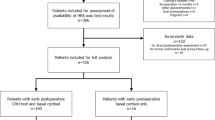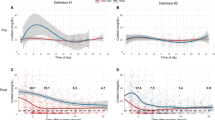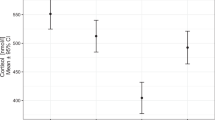Abstract
Rapid assessment of adrenal function is critical following transsphenoidal surgery (TSS) for Cushing’s disease (CD) in order to determine surgical efficacy. We hypothesize that there may be a role for ACTH measurement as a rapid indicator of adrenal function. Following surgery for CD, glucocorticoids were withheld and paired plasma ACTH and serum cortisol levels were measured every 6 h. Post-operative hypocortisolemia was defined as serum cortisol <2 mcg/dl or a serum cortisol <5 mcg/dl with the onset of symptoms of adrenal insufficiency within 72 h. We studied 12 subjects, all female, mean age 44.6 years (range 25–55), including 13 surgeries: nine subjects attained hypocortisolemia. Plasma ACTH levels decreased more in subjects with hypocortisolemia (0.9 pg/ml/hr, P = 0.0028) versus those with persistent disease (0 0.2 pg/ml/hr, P = 0.26) within the first 48 h after surgery. In contrast to subjects with persistent disease, all subjects with hypocortisolemia achieved a plasma ACTH <20 pg/ml by 19 h (range 1–19 h). Four of the nine subjects with hypocortisolemia achieved plasma ACTH <20 pg/ml by 13 h and the remaining five subjects by 19 h. Hypocortisolemia occurred between 3-36 h following achievement of a plasma ACTH <20 pg/ml. In CD, a reduction in postoperative plasma ACTH levels differentiates subjects with surgical remission versus subjects with persistent disease. The utility of plasma ACTH measurements in the postoperative management of CD remains to be determined.




Similar content being viewed by others
References
De Tommasi C, Vance ML, Okonkwo DO, Diallo A, Laws ER Jr (2005) Surgical management of adrenocorticotropic hormone-secreting macroadenomas: outcome and challenges in patients with Cushing’s disease or Nelson’s syndrome. J Neurosurg 103:825–830
Hammer GD, Tyrrell JB, Lamborn KR, Applebury CB, Hannegan ET, Bell S, Rahl R, Lu A, Wilson CB (2004) Transsphenoidal microsurgery for Cushing’s disease: initial outcome and long-term results. J Clin Endocrinol Metab 89:6348–6357
Reitmeyer M, Vance ML, Laws ER Jr (2002) The neurosurgical management of Cushing’s disease. Mol Cell Endocrinol 197:73–79
Esposito F, Dusick JR, Cohan P, Moftakhar P, McArthur D, Wang C, Swerdloff RS, Kelly DF (2006) Clinical review: early morning cortisol levels as a predictor of remission after transsphenoidal surgery for Cushing’s disease. J Clin Endocrinol Metab 91:7–13
Pouratian N, Prevedello DM, Jagannathan J, Lopes MB, Vance ML, Laws ER Jr (2007) Outcomes and management of patients with Cushing’s disease without pathological confirmation of tumor resection after transsphenoidal surgery. J Clin Endocrinol Metab 92:3383–3388
Chen JC, Amar AP, Choi S, Singer P, Couldwell WT, Weiss MH (2003) Transsphenoidal microsurgical treatment of Cushing disease: postoperative assessment of surgical efficacy by application of an overnight low-dose dexamethasone suppression test. J Neurosurg 98:967–973
Invitti C, Pecori Giraldi F, de Martin M, Cavagnini F (1999) Diagnosis and management of Cushing’s syndrome: results of an Italian multicentre study. Study Group of the Italian Society of Endocrinology on the Pathophysiology of the Hypothalamic-Pituitary-Adrenal Axis. J Clin Endocrinol Metab 84:440–448
Pimentel-Filho FR, Silva ME, Nogueira KC, Berger K, Cukiert A, Liberman B (2005) Pituitary-adrenal dynamics after ACTH-secreting pituitary tumor resection in patients receiving no steroids post-operatively. J Endocrinol Invest 28:502–508
Utz AL, Swearingen B, Biller BM (2005) Pituitary surgery and postoperative management in Cushing’s disease. Endocrinol Metab Clin North Am 34:459–478 xi
Biller BM, Grossman AB, Stewart PM, Melmed S, Bertagna X, Bertherat J, Buchfelder M, Colao A, Hermus AR, Hofland LJ, Klibanski A, Lacroix A, Lindsay JR, Newell-Price J, Nieman LK, Petersenn S, Sonino N, Stalla GK, Swearingen B, Vance ML, Wass JA, Boscaro M (2008) Treatment of adrenocorticotropin-dependent Cushing’s syndrome: a consensus statement. J Clin Endocrinol Metab 93:2454–2462
Arnaldi G, Angeli A, Atkinson AB, Bertagna X, Cavagnini F, Chrousos GP, Fava GA, Findling JW, Gaillard RC, Grossman AB, Kola B, Lacroix A, Mancini T, Mantero F, Newell-Price J, Nieman LK, Sonino N, Vance ML, Giustina A, Boscaro M (2003) Diagnosis and complications of Cushing’s syndrome: a consensus statement. J Clin Endocrinol Metab 88:5593–5602
Batista DL, Oldfield EH, Keil MF, Stratakis CA (2009) Postoperative testing to predict recurrent Cushing disease in children. J Clin Endocrinol Metab 94:2757–2765
Nishizawa S, Oki Y, Ohta S, Yokota N, Yokoyama T, Uemura K (1999) What can predict postoperative “endocrinological cure” in Cushing’s disease? Neurosurgery 45:239–244
Simmons NE, Alden TD, Thorner MO, Laws ER Jr (2001) Serum cortisol response to transsphenoidal surgery for Cushing disease. J Neurosurg 95:1–8
Patil CG, Prevedello DM, Lad SP, Vance ML, Thorner MO, Katznelson L, Laws ER Jr (2008) Late recurrences of Cushing’s disease after initial successful transsphenoidal surgery. J Clin Endocrinol Metab 93:358–362
Pimentel-Filho FR, Cukiert A, Miyashita F, Huayllas MK, Knoepfelmacher M, Salgado LR, Liberman B (2001) Adrenocorticotropin levels do not change during early recovery of transsphenoidal surgery for ACTH-secreting pituitary tumors. J Endocrinol Invest 24:83–87
Besser GM, Orth DN, Nicholson WE, Byyny RL, Abe K, Woodham JP (1971) Dissociation of the disappearance of bioactive and radioimmunoreactive ACTH from plasma in man. J Clin Endocrinol Metab 32:595–603
Czirjak S, Bezzegh A, Gal A, Racz K (2002) Intra- and postoperative plasma ACTH concentrations in patients with Cushing’s disease cured by transsphenoidal pituitary surgery. Acta Neurochir (Wien) 144:971–977 discussion 977
Graham KE, Samuels MH, Raff H, Barnwell SL, Cook DM (1997) Intraoperative adrenocorticotropin levels during transsphenoidal surgery for Cushing’s disease do not predict cure. J Clin Endocrinol Metab 82:1776–1779
Pereira AM, van Aken MO, van Dulken H, Schutte PJ, Biermasz NR, Smit JW, Roelfsema F, Romijn JA (2003) Long-term predictive value of postsurgical cortisol concentrations for cure and risk of recurrence in Cushing’s disease. J Clin Endocrinol Metab 88:5858–5864
Flitsch J, Knappe UJ, Ludecke DK (2003) The use of postoperative ACTH levels as a marker for successful transsphenoidal microsurgery in Cushing’s disease. Zentralbl Neurochir 64:6–11
Author information
Authors and Affiliations
Corresponding author
Rights and permissions
About this article
Cite this article
Srinivasan, L., Laws, E.R., Dodd, R.L. et al. The dynamics of post-operative plasma ACTH values following transsphenoidal surgery for Cushing’s disease. Pituitary 14, 312–317 (2011). https://doi.org/10.1007/s11102-011-0295-2
Published:
Issue Date:
DOI: https://doi.org/10.1007/s11102-011-0295-2




